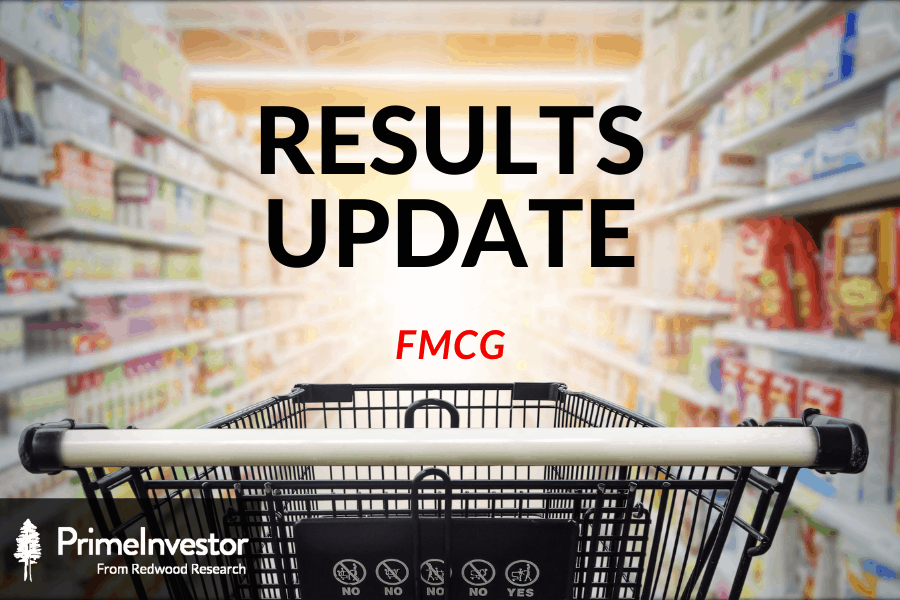Most of the FMCG majors posted stellar numbers for the March 2021 quarter. But this performance has come by mainly due to favourable base effect. Moreover, there are two key challenges ahead to FMCG majors continuing to post strong numbers. One, the disruption that the second Covid wave can cause and two, the recent surge in input cost prices across agri-commodities and packaging materials.
These challenges pose threat to the net earnings growth for this sector, which is already not cheap in valuations. This also comes at a time when markets could look to ‘defensive’ plays such as FMCG should the economic fallout from lockdowns and the pandemic be worse than expected.
To judge this, as well as how companies plan to tackle the challenges ahead, we looked at the management commentary of the key players in this FMCG results reason.

March ’21 quarter performance at a glance
We considered 5 FMCG majors – Hindustan Unilever (HUL), Dabur India, Britannia, Marico and Nestle India. These five companies represent a broad swathe of FMCG segments, covering home & personal Care, food & beverages, health & nutrition, cooking oil, biscuits & snacks and so on.
Here are some key highlights from these results:
- HUL has led the sector in earnings growth, but this is primarily due to the GSK acquisition. The company still leads peers in margin profile, led by its high margin beauty & personal care segment. However, post the GSK acquisition, the share of this segment and home care, two of HUL’s primary segments can drop in favour of foods.
- For Dabur, the healthcare segment emerged the key growth driver, with the segment’s contribution jumping to 39% in FY20 against the previous 35%.
- For Marico, it is the Saffola brand that led the growth in both value and volume, be it in edible oils or health foods
- The outlier in the major FMCG pack was Britannia, which suffered profit impact in the Jan-Mar 21 quarter due to input cost pressures and a temporary shutdown related to digital transformation.
While that’s the picture so far, how do FMCG companies see the coming quarters and what are they doing to tackle any Covid-related fallout? Parsing the management commentary for the five companies throws up the following observations.
#1 Better prepared to tackle disruptions
Unlike in the first Covid wave where production was impacted from plant closures, companies seem to be better prepared and more confident this time. Factories are running and supply chains are still operating with minimal disruption. Regulatory clearances to run factories are also comparatively less delayed. This time around, companies do not believe that the impact is going to be as hard as the April-June 2020 quarter.
A common strategy that companies appear to be adopting is to maintain more stocks and support distributors. Companies have also invested heavily in digital infrastructure to shrink response time and improve the efficiency of their supply chains. Britannia and Nestle, for example, are focusing on distribution and supply chain as their products tend go off shelves during lock-downs. Britannia has implemented three transformational digital projects in Q4 to enhance its distribution strength and reduce response time.
Two, focus is shifting to key segments that will find customer offtake such as hygiene, nutrition, healthcare, and health foods – segments where demand can be more resilient compared to other discretionary segment in the near term. While HUL has a strong portfolio of hygiene and nutrition products, Dabur is sharpening focus on its ayurvedic healthcare portfolio and Marico on its Foods & healthy cooking oil portfolio.
#2 Mixed outlook on demand
As far as demand outlook goes, the picture appears difficult to draw. HUL’s commentary suggests that the changing scenario and the unprecedented drastic wave has made it hard to estimate demand or predict demand. The company, therefore, is focusing on delivering volume growth; it has significantly ramped up its distribution network to tackle changing demand.
Marico hopes to hold its medium term aspiration of 8-10% domestic volume growth and 13-15% revenue growth. However, the management also expressed concern over the magnitude of the current Covid wave and expects a clearer picture to emerge only later. The company did witness business impact in the last 10 days of April and will continue to track the evolving situation. On the other hand, Nestle’s management commentary does not appear especially worried about a deeper demand impact. Britannia is banking on deeper penetration and market share gains in a key category where it has only low single digit market share.
#3 Challenges from input cost escalation
If demand outlook is uncertain, FMCG companies are now also contending with rising input costs. Key commodity prices such as palm oil, tea, edible oil, milk, and crude oil derivatives are all on the rise. Therefore, profit margins across key segments may see challenges.
For example, palm oil prices during the latest March quarter rose 24%, while rice bran oil jump 39% in the March 21 quarter over the year ago period. Milk prices have also begun rising. Prices of tea in Indian auctions rose by approximately 46% according to a latest data available. Crude derivatives such as Liquid Paraffin (LLP) and HDPE were also up 29% and 31% YoY in Q4, respectively according to updates from Marico.
To some extent, companies have pursued cost-saving measures to offset impact of pricier inputs. Companies are also resorting to methods such as strategic buying and calibrated price increases to mitigate the challenges. While some have already undertaken price hikes, others are weighing on increases in the June 2021 quarter, considering competitive position. Companies like HUL seem to be focusing more on keeping volumes sustained while those such as Marico are looking at aggressive price action as well. All in all, companies want to respond to the situation in a judicious manner without impacting volumes.
Also Read : Results Update – Tech majors moving to a new orbit






2 thoughts on “FMCG Results Update – A bumper Q4 is not a sign of what lies ahead”
Though ITC is not a pure FMCG player but if we remove the Cigarette business it has decent volume in this sector to be compared. It would be good to see that along with other companies to get a complete view of the sector.
Sir, it is not yet comparable with others in performance. Will do once it improves. Thank you
Comments are closed.